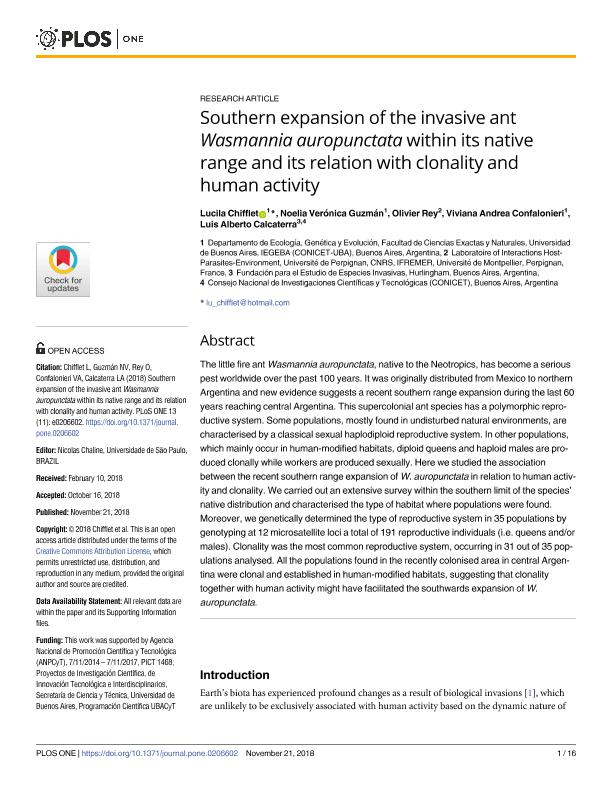Mostrar el registro sencillo del ítem
dc.contributor.author
Chifflet, Lucila

dc.contributor.author
Guzman, Noelia Veronica

dc.contributor.author
Rey, Oliver
dc.contributor.author
Confalonieri, Viviana Andrea

dc.contributor.author
Calcaterra, Luis Alberto

dc.date.available
2020-02-03T20:15:24Z
dc.date.issued
2018-11
dc.identifier.citation
Chifflet, Lucila; Guzman, Noelia Veronica; Rey, Oliver; Confalonieri, Viviana Andrea; Calcaterra, Luis Alberto; Southern expansion of the invasive ant Wasmannia auropunctata within its native range and its relation with clonality and human activity; Public Library of Science; Plos One; 13; 11; 11-2018; 1-16
dc.identifier.issn
1932-6203
dc.identifier.uri
http://hdl.handle.net/11336/96579
dc.description.abstract
The little fire ant Wasmannia auropunctata, native to the Neotropics, has become a serious pest worldwide over the past 100 years. It was originally distributed from Mexico to northern Argentina and new evidence suggests a recent southern range expansion during the last 60 years reaching central Argentina. This supercolonial ant species has a polymorphic reproductive system. Some populations, mostly found in undisturbed natural environments, are characterised by a classical sexual haplodiploid reproductive system. In other populations, which mainly occur in human-modified habitats, diploid queens and haploid males are produced clonally while workers are produced sexually. Here we studied the association between the recent southern range expansion of W. auropunctata in relation to human activity and clonality. We carried out an extensive survey within the southern limit of the species’ native distribution and characterised the type of habitat where populations were found. Moreover, we genetically determined the type of reproductive system in 35 populations by genotyping at 12 microsatellite loci a total of 191 reproductive individuals (i.e. queens and/or males). Clonality was the most common reproductive system, occurring in 31 out of 35 populations analysed. All the populations found in the recently colonised area in central Argentina were clonal and established in human-modified habitats, suggesting that clonality together with human activity might have facilitated the southwards expansion of W. auropunctata.
dc.format
application/pdf
dc.language.iso
eng
dc.publisher
Public Library of Science

dc.rights
info:eu-repo/semantics/openAccess
dc.rights.uri
https://creativecommons.org/licenses/by-nc-sa/2.5/ar/
dc.subject
invasive ant
dc.subject
pest
dc.subject
polymorphic reproductive system
dc.subject.classification
Genética y Herencia

dc.subject.classification
Ciencias Biológicas

dc.subject.classification
CIENCIAS NATURALES Y EXACTAS

dc.title
Southern expansion of the invasive ant Wasmannia auropunctata within its native range and its relation with clonality and human activity
dc.type
info:eu-repo/semantics/article
dc.type
info:ar-repo/semantics/artículo
dc.type
info:eu-repo/semantics/publishedVersion
dc.date.updated
2019-10-09T20:43:36Z
dc.journal.volume
13
dc.journal.number
11
dc.journal.pagination
1-16
dc.journal.pais
Estados Unidos

dc.journal.ciudad
San Francisco
dc.description.fil
Fil: Chifflet, Lucila. Consejo Nacional de Investigaciones Científicas y Técnicas. Oficina de Coordinación Administrativa Ciudad Universitaria. Instituto de Ecología, Genética y Evolución de Buenos Aires. Universidad de Buenos Aires. Facultad de Ciencias Exactas y Naturales. Instituto de Ecología, Genética y Evolución de Buenos Aires; Argentina
dc.description.fil
Fil: Guzman, Noelia Veronica. Consejo Nacional de Investigaciones Científicas y Técnicas. Oficina de Coordinación Administrativa Ciudad Universitaria. Instituto de Ecología, Genética y Evolución de Buenos Aires. Universidad de Buenos Aires. Facultad de Ciencias Exactas y Naturales. Instituto de Ecología, Genética y Evolución de Buenos Aires; Argentina
dc.description.fil
Fil: Rey, Oliver. Centre National de la Recherche Scientifique; Francia
dc.description.fil
Fil: Confalonieri, Viviana Andrea. Consejo Nacional de Investigaciones Científicas y Técnicas. Oficina de Coordinación Administrativa Ciudad Universitaria. Instituto de Ecología, Genética y Evolución de Buenos Aires. Universidad de Buenos Aires. Facultad de Ciencias Exactas y Naturales. Instituto de Ecología, Genética y Evolución de Buenos Aires; Argentina
dc.description.fil
Fil: Calcaterra, Luis Alberto. Consejo Nacional de Investigaciones Científicas y Técnicas; Argentina. Fundación para el Estudio de Especies Invasivas; Argentina
dc.journal.title
Plos One

dc.relation.alternativeid
info:eu-repo/semantics/altIdentifier/doi/https://doi.org/10.1371/journal.pone.0206602
dc.relation.alternativeid
info:eu-repo/semantics/altIdentifier/url/https://journals.plos.org/plosone/article?id=10.1371/journal.pone.0206602
Archivos asociados
